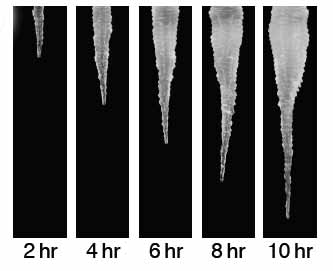“A complete theory of icicle shape, including tip growth, self-similarity and the ripple instability, is currently lacking.”
Prompting professor Stephen W. Morris and Antony Szu-Han Chen from the Department of Physics, at the University of Toronto, Canada to construct ‘An apparatus for the controlled growth of icicles’. The team used their specially designed table-top apparatus (with a rotating support) in an attempt to grow what they call ‘ideal icicles’: In total, they managed to grow 93, both from distilled water and common tap water.
"The most ideal icicles were found for distilled water and gently stirred air. Icicles grown in still air had a higher probability of forming multiple tips. The latter condition contradicts the assumptions of the self-similarity theory, but nevertheless improves the agreement with it.”
A number of the icicles, however, were found to be non-ideal. Some had branched or even split tips. And some showed signs of rippling – which the team also investigated. For, as sometimes happens, unforeseen experimental side-effects provided opportunities for further study.
“A particularly good sample of ripples was found on a long finger of ice that fortuitously formed when the drain of the refrigerated box froze.”
See the paper : ‘Experiments on the morphology of icicles’
(arXiv:1008.1922v1 [nlin.PS] 11 Aug 2010)





Comments